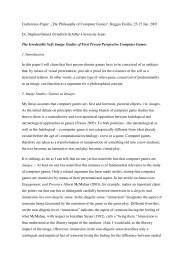Playing Dress-Up: Costumes, roleplay and imagination
Playing Dress-Up: Costumes, roleplay and imagination
Playing Dress-Up: Costumes, roleplay and imagination
Create successful ePaper yourself
Turn your PDF publications into a flip-book with our unique Google optimized e-Paper software.
<strong>Playing</strong> <strong>Dress</strong>-<strong>Up</strong> Ludica<br />
Miller’s research <strong>and</strong> theoretical work on gender <strong>and</strong> costume play posits some interesting findings <strong>and</strong><br />
theories. In a questionnaire on fantasy dress of 216 respondents, men more frequently cited “historical<br />
reenactment” as a motivation for dress-up, while women’s first choice in motivation was “opportunity to<br />
assume a different role,” which was cited by men as the second most frequent motivation. In qualitative<br />
research, Miller found that some men tended to veer away from the terms “costume,” <strong>and</strong> “fantasy,”<br />
which may be associated with female activities. She also hypothesizes that costume play may afford men<br />
more opportunity for creative expression than everyday dress, as well as the opportunity to wear weapons<br />
in public, a decidedly masculine-associated activity. The qualitative aspect of her research also revealed<br />
that many women considered real-world dress a form of costuming, <strong>and</strong> made less of a distinction<br />
between fantasy <strong>and</strong> real-world dress. (Miller 1998)<br />
These findings suggest an interesting implication for digital dress up: Perhaps the conflation of the<br />
“masculine” space of the computer, combined with the notion of “gear” (armor <strong>and</strong> weapons) actually<br />
regenders costume play in more masculine direction. What this suggests is that while costume play on<br />
computers may be creating more female-friendly play opportunities, conversely, it may also be opening<br />
up more avenues of dress-up for men.<br />
The Burning Man festival, with its 30,000 plus attendees, is another contemporary example of the role of<br />
costume play in contemporary American culture. Burning Man, which takes place annually in the Nevada<br />
desert over a weeklong period, presents a particularly compelling example of what Robert Kozinets refers<br />
to as an “anti-market” event that supports communality, disparages market logics, offer alternative<br />
exchange practices, <strong>and</strong> supports personal expression as a form of both production <strong>and</strong> consumption.<br />
(Kozinets, 2002, p.1) Because of the harsh physical environment, it combines the realities of survival with<br />
the performative qualities of a masquerade ball, resulting in a high level of ingenuity. (For more on<br />
Burning Man, see Gilmore et al. 2005.)<br />
Figure 13: “Burners” in various personas, Burning Man 2004. (Images: Morie)<br />
Along with its position as subversive cultural practice, Burning Man also exemplifies the role that<br />
creativity <strong>and</strong> preparation ritual plays in costume <strong>and</strong> dress-up play. As with the Mardi Gras, many<br />
participants spend the entire year planning for this event, producing art works <strong>and</strong> elaborate costumes<br />
which run the gamut from three-piece suits (including shoes) made entirely out of money to colorfully<br />
painted (but otherwise naked) bodies. In this “clothing optional” atmosphere, participants can don<br />
elaborate costumes or appear in only in their aesthetic metals piercings, which would not be visible in<br />
Philosophy of Computer Games 2007 Page 13






